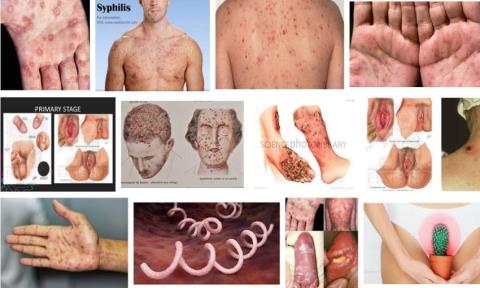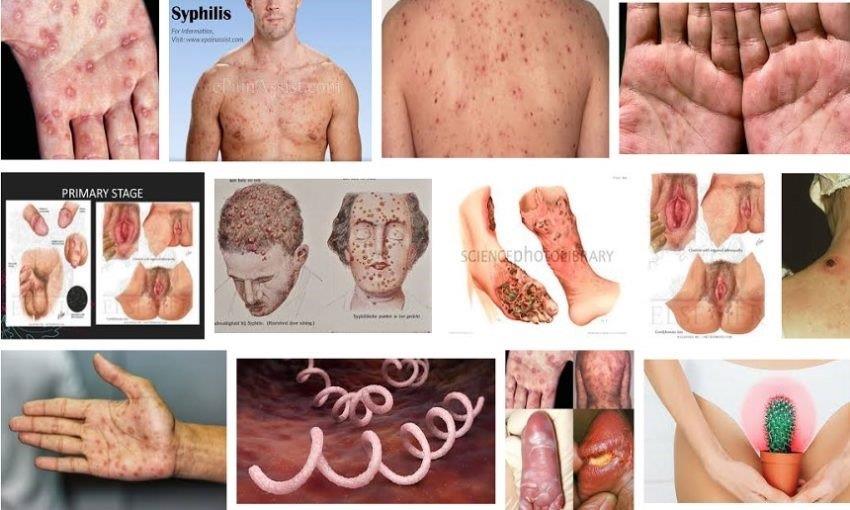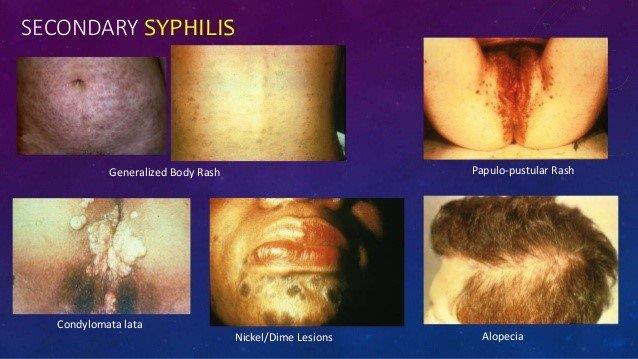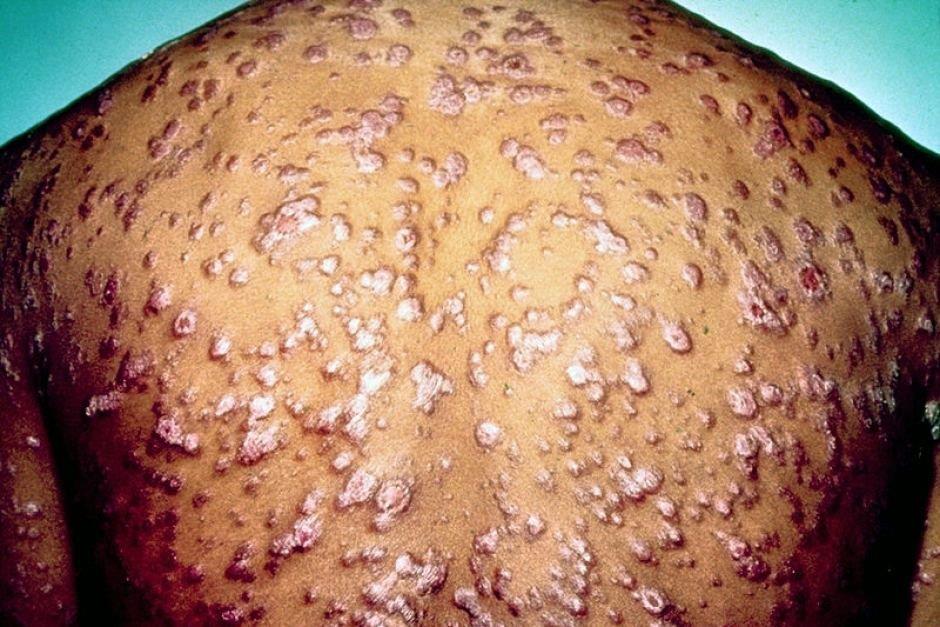The stages of syphilis not everyone knows!

Sexually transmitted diseases (STDs) – or sexually transmitted infections (STIs) – are diseases that occur after sexual contact such as gonorrhea, syphilis, HIV/AIDS, Chlamydia infection, etc. It is a common sexually transmitted disease that affects the whole body. If not diagnosed and treated, syphilis can cause damage to many organs such as the genitals, skin, lymph nodes, bones, joints, heart, and nerves. Learn how to recognize and prevent syphilis.
content
1. What is syphilis?
Syphilis is a systemic disease caused by the bacterium Treponema pallidum .
Thanks to the mobility by twisting the spring, bacteria can easily penetrate the mucosa even when the mucosa is completely intact. The spirochete Treponema pallidum mainly causes disease in people through direct contact such as sex. Less commonly, the bacteria can also be spread through other ways, such as kissing, scraping the skin, through blood transfusions or sharing syringes. Contamination through clothing and other common items is still controversial.
>> Syphilis is a dangerous sexually transmitted disease. So what is Giang Mai?
Syphilis is a systemic disease, manifesting in many stages of the disease and affecting many different organ systems such as skin, mucous membranes, lymph nodes in the early stages and complications on nerves, bones, joints, and cardiovascular system in the early stages. delay segment. Syphilis can be latent with many stages making it difficult to diagnose and especially to control its spread. Syphilis infection is also often accompanied by other sexually transmitted diseases such as HIV , gonorrhea, etc.
Congenital syphilis is a syphilis infection in infants caused by maternal infection.
Prevention through safe sex and early treatment are the best ways to prevent the spread of syphilis and its dangerous complications.

2. The stages of syphilis
The course of syphilis is so unpredictable and can be confused with other diseases that it is also called “the greate pretender”. If left untreated, syphilis lasts for many years and progresses through stages.
-
Early morning syphilis:
Syphilis stage I with chancre and lymphadenopathy at the site of infection.
Stage II syphilis with skin and body rashes.
Early latent syphilis (less than 2 years – according to WHO)
-
Late syphilis:
Late latent syphilis (more than 2 years – according to WHO)
Stage III syphilis manifests as neurosyphilis, cardiovascular syphilis, and gum syphilis.
2.1. Syphilis period 1
Primary syphilis or primary syphilis is characterized by a solitary “syphilis chancre”.
Syphilis spirochetes are very mobile, so they can easily penetrate the mucosa. After an incubation period of about 21 days (9-90 days), syphilis scabs appear at the site of infection. Syphilis chancres are typically round or oval in shape; clear, slightly rough shore; painless; red clean bottom; hard background.
In women, syphilis is usually found on the labia majora, possibly in the vagina or cervix. In men, syphilis is usually found on the penis. However, swelling can also be seen in other sites such as palate, tongue or anus-rectum due to sex through these routes.
Syphilis chancre is often accompanied by lymph nodes. The lymph nodes appear posteriorly, usually in the ipsilateral inguinal region, are firm, mobile, and painless.
Syphilis chancre can heal on its own in 3 to 10 weeks without being detected by the patient. Without treatment, the bacteria enter the bloodstream and after 4-8 weeks from primary syphilis, the disease turns to stage II syphilis.
2.2. Syphilis period II
Manifestations of stage II syphilis are red and brown rashes or papules that appear on both the skin and mucous membranes. The rash of stage II syphilis can be widespread and easily confused with other diseases, but especially the rash appears on the palms and soles. Rash of red or brown papules of various sizes, usually symmetric, and painless. There may also be other symptoms such as swollen lymph nodes, fever, headache, weight loss, muscle pain, and "termite-like" hair loss.
In areas of warmer, wetter skin, such as the anus or genitals, patches of gray or white ridges are raised, due to the spread of spirochetes from the original syphilis. These patches are often referred to as condylomata lata, which should be distinguished from warts and other diseases.
These symptoms of stage II syphilis will also go away on their own after 2 to 6 weeks.
If left untreated, the disease will enter the latent stage of syphilis.

2.3. Latent Syphilis
Latent syphilis can last for a very long time, and is characterized by positive syphilis serological tests even though the disease does not present any symptoms or signs.
Symptoms can still recur at any time.
Latent syphilis is usually divided into 2 stages:
- Early latent syphilis: before 2 years (according to WHO)
- Late latent syphilis: less contagious than early stage, but treatment at this stage is often more difficult.
About 25% of patients with late latent syphilis progress to stage III syphilis, the severe sequelae of syphilis.
2.4. Syphilis period III
Stage III syphilis can last 10 to 30 years and can affect multiple organ systems. The main manifestations of stage III syphilis are neurosyphilis, cardiovascular syphilis and gum syphilis.
Neurosyphilis can occur at any stage of infection, even in the early months. Acute manifestations of neurological symptoms include disturbances of consciousness, meningitis, stroke , cranial nerve dysfunction such as blurred vision, hearing loss. In later stages there may be effects on the spinal cord.
Syphilis gums are granular, heavily necrotic lesions, lesions can be found in bones, joints, cardiovascular, nerves, eyes and ears.

3. Diagnosis and treatment of syphilis i
See your doctor for advice, screening and treatment when:
- you have any symptoms of syphilis or other sexually transmitted diseases such as sores on the genitals, anus, oropharynx; discharge, pus discharge from the genitals, abdominal pain, skin rash...
- Your sex partner has been diagnosed with syphilis or any other STDs.
- You have unprotected sex and need to be screened.
>> In addition to syphilis, other sexually transmitted diseases are equally dangerous. Find out now!
When you see your doctor, you'll have a gynecological or gynaecological exam and a test to diagnose syphilis. Common tests are:
- Finding mobile spirochetes on a black background microscope
- Test for fluorescein antibodies from diseased lesions or lymph node aspiration.
- Blood tests (serological tests): There are 2 types: non-Treponema test and Treponema test. Syphilis is diagnosed when both serological tests are positive.
Depending on the results and stage of the disease, your doctor will choose the right antibiotic regimen to treat syphilis. It is necessary to notify sexual partners for examination and treatment. Don't have sex until you're sure you've recovered from the treatment.
>> You may be interested: How to prevent sexually transmitted diseases

Syphilis is a dangerous disease that affects many organs if not treated properly. Each person needs to equip themselves with knowledge about safe sex to prevent STDs and protect themselves and their loved ones. Seek medical advice and treatment immediately if you have any symptoms.
Doctor Le Mai Thuy Linh